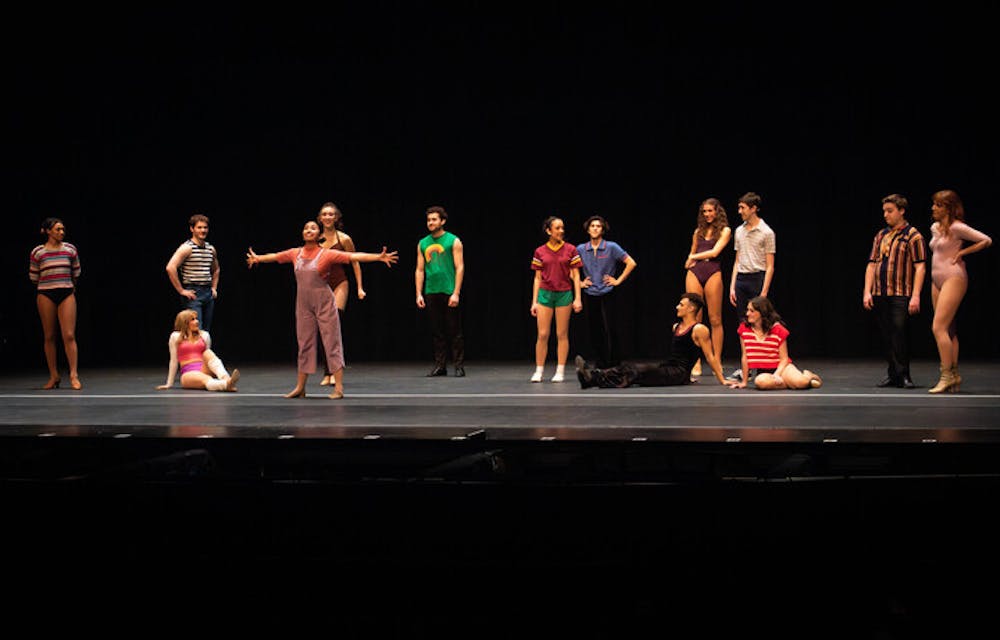Freshman Eric Pettit remembers auditioning for Elon University’s music theatre program, trying to stand out among his peers in hopes of getting in. For his first Elon show, Pettit said he found himself channeling that energy again as he played Mark Anthony in “A Chorus Line.”
“It is kind of meta and weird to then be like, ‘I get here and I made it. I wanted to go here, this is great.’ And then my first main stage show is doing exactly what is so true for all of us,” Pettit said.
Elon’s winter musical, “A Chorus Line,” had four sold out performances from Feb. 8 to 10 and follows a group of dancers auditioning for a Broadway show in the 1970s — a tough time for ticket sales. Pettit’s character is the youngest dancer in the audition, something he said he resonated with as one of the few freshmen in the cast.
“For these people who dance in the ensemble of these shows, it's work. It's hard. it's thankless a lot of the time,” Pettit said. “What I've loved so much about getting to dive into this show is — as someone who was majoring in music theatre and wants to do this as my job — getting to tell the stories of real people who were doing this in the 70s.”
The Broadway classic “A Chorus Line” premiered in 1975 and won a Pulitzer Prize the following year. While there have been a wide variety of “A Chorus Line” productions and revivals, Pettit said Elon’s production was intentionally very reminiscent of the original Broadway production.
Visiting professor Jane Lanier directed the show and said the performance kept most of the original staging and concept of Michael Bennett, who directed and choreographed the original.
Lanier herself is no stranger to the show. Over the past 33 years, she has played Cassie in regional productions; choreographed for university productions, including University of California, Los Angeles; and directed and choreographed the show in Chicago just last year.

When bringing “A Chorus Line” to Elon, Lanier said while she wanted to keep Bennett’s legacy alive through the staging and choreography, she also wanted to highlight the strengths of each cast member.
“There's a lot of big ensemble numbers, but then there's individual stories, so I really wanted to cast it, see, get to know the performer and bring their own take to the story instead of putting something on them, created it together with their sensibilities and essence and strengths,” Lanier said.
While “A Chorus Line” takes place during an audition, Pettit said the show's messages run deeper than show business; it’s a story about sacrifice, self-discovery, family dynamics and growing up told through the lens of a Broadway audition.
Lanier said one of the reasons “A Chorus Line” continues to resonate with audiences across generations is the recurring theme of what these performers are willing to sacrifice to pursue their passions and do what they love.
“Everyone has that no matter what line of work you're in,” Lanier said.
After rehearsing six days a week during Winter Term, Pettit said one of his favorite parts of the process was performing the finale with the band for the first time.
“I feel like that was one of the moments — which I've had a couple of in the show — to be like, ‘Whoa, I'm at Elon University,” Pettit said.
Professor Courtney Liu choreographed the show and said it was rewarding to watch the cast grow into the techniques, stamina and confidence needed for “A Chorus Line.” Liu said some of the students in the cast didn't dance before Elon and are now performing some of the most advanced choreography Broadway has seen.
“It makes me emotional to see them reach new heights,” Liu said.
Liu said she distinctly remembered how proud she was the first time the cast performed “Montage, Part 4,” which Lanier said is nicknamed “Monster” in part due to its complex choreography.
While the stories told in “A Chorus Line” are important, the story behind the show also carries weight.
“Everyone knows the show in our community. It changed the way that we do lighting, it changed the way that we think about dancers. Many historians claim that it saved Broadway economically,” Liu said. “It's in our history classes.”
Lanier described “A Chorus Line” as one of the first shows “to give dancers a voice.”
“To pass the knowledge that I have from doing it for so long and learning the original down to this generation, we keep it alive that way,” Lanier said.


